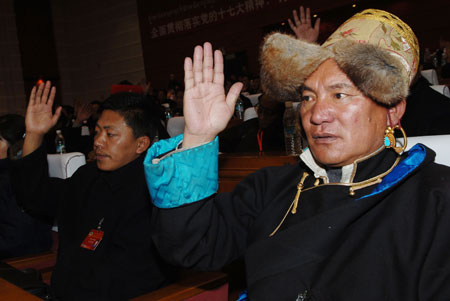 |
|
Representatives of the Tibetan ethnic group vote during an election in southwest China's Tibet Autonomous Region, Jan. 20, 2008. Under the Chinese laws, the people of Tibet can directly elect deputies to grassroots-level people's congress, China's legislative body, who in turn elect deputies to provincial and national people's congresses, according to the white paper titled "Fifty Years of Democratic Reform in Tibet" released on March 2, 2009 by the Information Office of the State Council, or China's Cabinet. (Xinhua/Chogo) |
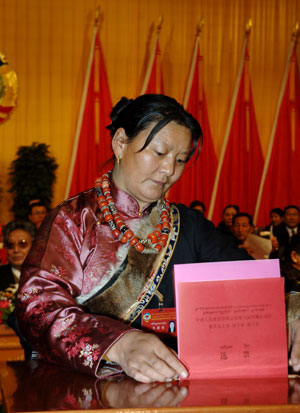 |
|
A woman of the Tibetan ethnic group votes during an election in southwest China's Tibet Autonomous Region, Jan. 20, 2008.(Xinhua/Chogo) |
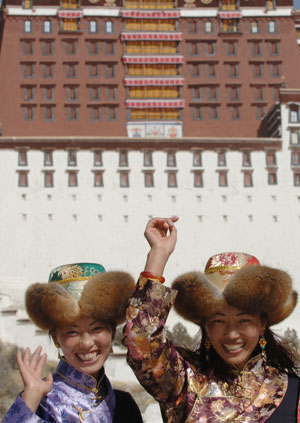 |
|
Two women pose for photos in front of the Potala Palace in Lhasa, capital of southwest China's Tibet Autonomous Region, Feb. 11, 2008. Tibet Autonomous Region is in its best period of development after 50 years of economic development and social progress under the leadership of the Communist Party of China, according to the white paper titled "Fifty Years of Democratic Reform in Tibet" released on March 2, 2009 by the Information Office of the State Council, or China's Cabinet. (Xinhua/Chogo) |
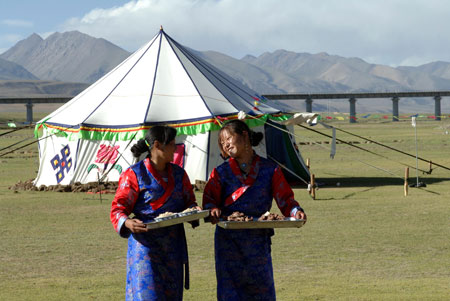 |
|
Two women prepare to welcome tourists in the north of southwest China's Tibet Autonomous Region June 25, 2007.(Xinhua/Chogo) |
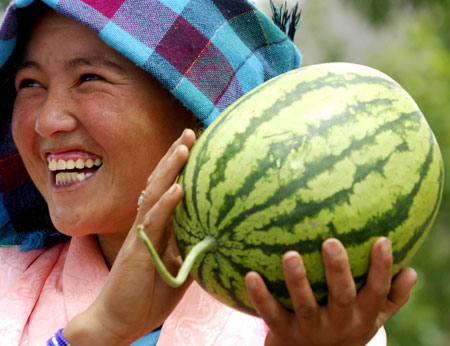 |
|
A farmer is happy with the good harvest of watermelon in Xigaze, southwest China's Tibet Autonomous Region, June 15, 2007.(Xinhua/Chogo) |
 |
|
Farmers practise a ritual to express their gratitude to the happy life in Quxu County, southwest China's Tibet Autonomous Region, Jan. 20, 2007.(Xinhua/Chogo) |
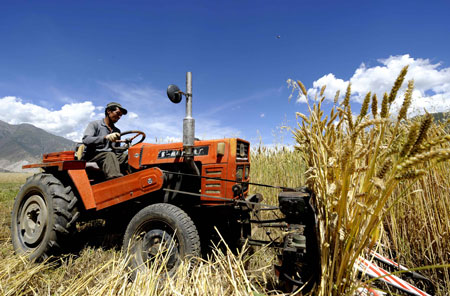 |
|
Farmer Gesang of the Tibetan ethnic group harvests wheat in Caigongtang Township of Lhasa, capital of southwest China's Tibet Autonomous Region, Aug. 23, 2008. Tibet has seen its GDP soar from 174 million RMB yuan (25.44 million U.S. dollars) in 1959 to 39.591 billion yuan (5.79 billion dollars) in 2008, with an annual growth rate of 8.9 percent on the average, according to the white paper titled "Fifty Years of Democratic Reform in Tibet" released on March 2, 2009 by the Information Office of the State Council, or China's Cabinet. (Xinhua/Purbu Zhaxi) |
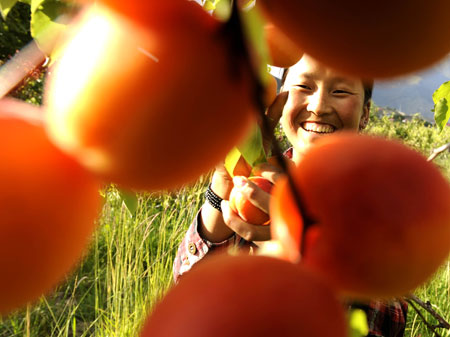 |
|
A girl of the Tibetan ethnic group picks fruits in Nyingchi, southwest China's Tibet Autonomous Region, July 9, 2008.(Xinhua/Purbu Zhaxi) |
 |
|
A herdsman of the Tibetan ethnic group talks on the mobile phone in northern Tibet Autonomous Region June 26, 2008.(Xinhua/Purbu Zhaxi) |
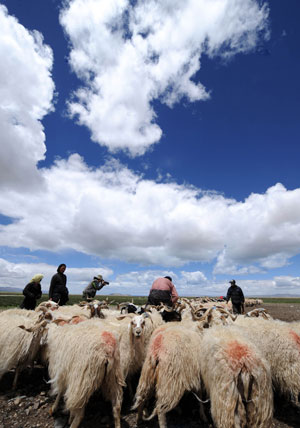 |
|
The family of Nuri milk sheep in Dangxiong County in the north of southwest China's Tibet Autonomous Region June 26, 2008.(Xinhua/Chogo) |
 |
|
A flock of sheep are seen in the north of southwest China's Tibet Autonomous Region June 26, 2008. (Xinhua/Chogo) |
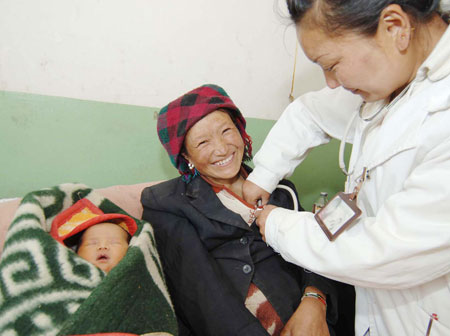 |
|
A woman (L) receives medical checkup at a hospital in Dagze County, southwest China's Tibet Autonomous Region, April 9, 2007. The population in Tibet increased from 1.228 million in 1959 to 2.8708 million in 2008, according to the white paper titled "Fifty Years of Democratic Reform in Tibet" released on March 2, 2009 by the Information Office of the State Council, or China's Cabinet. The past 50 years have seen the fastest population expansion in the region for centuries. (Xinhua/Purbu Zhaxi) |
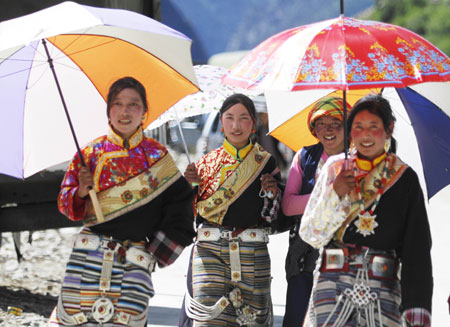 |
|
Girls of the Tibetan ethnic group attend a festival in Nyingchi, southwest China's Tibet Autonomous Region, July 17, 2008.(Xinhua/Purbu Zhaxi) |
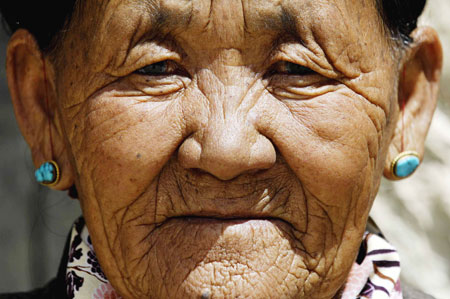 |
|
Photo taken on April 19, 2008 shows Cering, a 79-year-old woman of the Tibetan ethnic group in Xigaze, southwest China's Tibet Autonomous Region. (Xinhua/Purbu Zhaxi) |
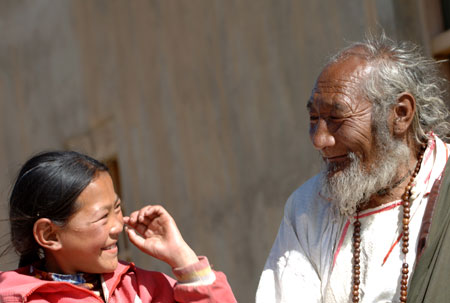 |
|
An old man and his granddaughter share a happy moment in Nagqu Town, southwest China's Tibet Autonomous Region, June 13, 2006. (Xinhua/Chogo) |
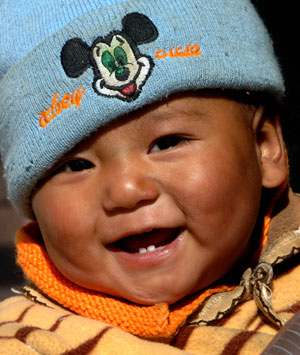 |
|
Photo taken on March 21, 2007 shows a child on the outskirts of Lhasa, capital of southwest China's Tibet Autonomous Region.(Xinhua/Chogo) |
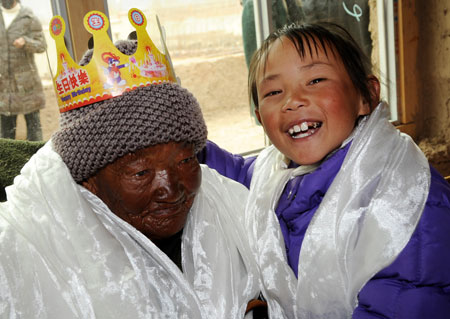 |
|
Ngamai Cering (L), a 117-year-old woman of the Tibetan ethnic group, is with her great granddaughter Cering Medog in southwest China's Tibet Autonomous Region in March 2008.(Xinhua/Chogo) |
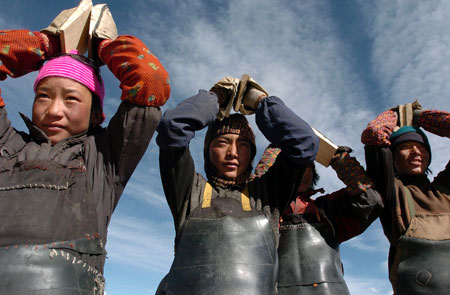 |
|
Followers of the Tibetan Buddhism practise kowtow, a ritual in Tibetan Buddhism to express the followers' most honest heart to the Buddha, as they walk from their hometowns in the north of southwest China's Tibet Autonomous Region to Lhasa, the region's capital, Jan. 10, 2007. The freedom of religious belief and normal religious activities of the Tibetan people are protected. Today, there are more than 1,700 religious venues in Tibet, with more than 46,000 resident monks and nuns, which can fully meet the needs of religious believers in Tibet, according to the white paper titled "Fifty Years of Democratic Reform in Tibet" released on March 2, 2009 by the Information Office of the State Council, or China's Cabinet. (Xinhua/Chogo) |
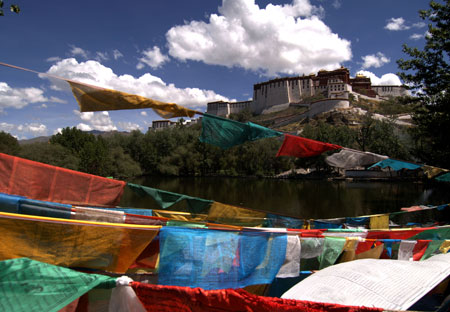 |
|
Photo taken on June 4, 2006 shows the Potala Palace surrounded with sutra streamers in Lhasa, capital of southwest China's Tibet Autonomous Region. (Xinhua/Chogo) |
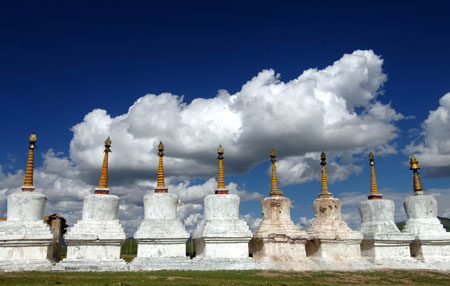 |
|
Photo taken on Aug. 12, 2007 shows Buddhist pagodas in the north of southwest China's Tibet Autonomous Region. (Xinhua/Chogo) |
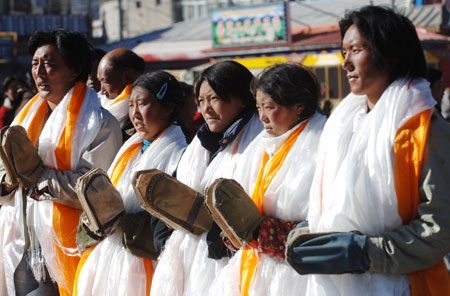 |
|
Followers of the Tibetan Buddhism arrive in Lhasa, capital of southwest China's Tibet Autonomous Region, in November 2007, after a long worship road by practising kowtow to express their most honest heart to the Buddha.(Xinhua/Soinam Norbu) |
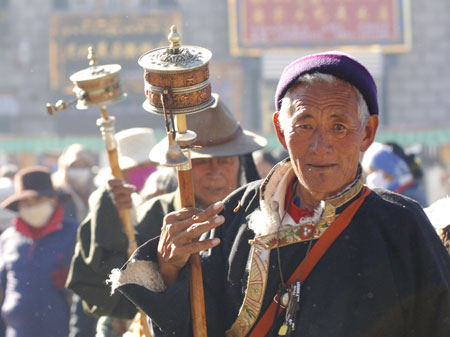 |
|
Buddhism followers of the Tibetan ethnic group spin their prayer wheels to spread spiritual blessings to all sentient beings and invoke good karma in their next life when walking on a street in Lhasa, capital of southwest China's Tibet Autonomous Region, in November 2007.(Xinhua/Soinam Norbu) |
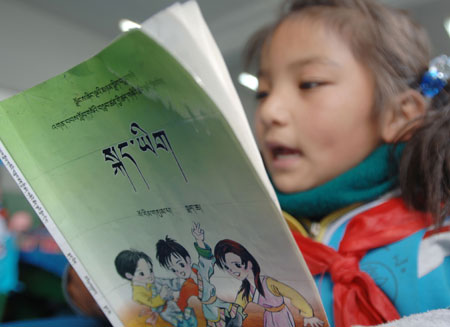 |
|
Dainzin of the Tibetan ethnic group attends class of the Tibetan language at No. 1 Primary School in Lhasa, capital of southwest China's Tibet Autonomous Region, in this undated photo. During the past 50 years, China's central government has invested a huge amount of funds in education in Tibet, making Tibet the first place in China to enjoy free compulsory education in both urban and rural areas. Since 1985, the state has set up boarding primary and high schools in farming and pastoral areas, and covered all tuition as well as food and lodging expenses for students at the stage of compulsory education from Tibet's farming and pastoral families, according to the white paper titled "Fifty Years of Democratic Reform in Tibet" released on March 2, 2009 by the Information Office of the State Council, or China's Cabinet.(Xinhua/Purbu Zhaxi) |

